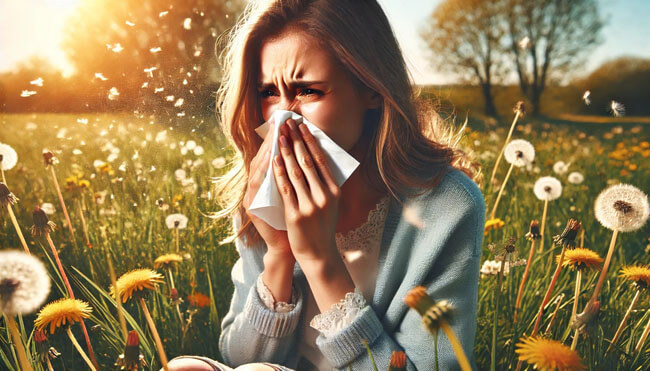Hay fever, also known as allergic rhinitis, is a widespread condition that affects millions of individuals worldwide, particularly during periods of high pollen concentration, such as spring and early summer. It is triggered by allergens like pollen from trees, grasses, and flowers, which provoke an overreaction of the immune system in sensitive individuals. The body’s immune response releases histamines and other chemicals, causing symptoms that range from mild discomfort to severe irritation. Common symptoms include frequent sneezing, itchy or watery eyes, nasal congestion, a runny nose, and even a sore throat. For many, these symptoms can significantly impact daily life, leading to fatigue, irritability, and poor concentration.
Traditional treatments for hay fever typically involve the use of antihistamines, decongestants, or corticosteroids, but these can sometimes lead to unwanted side effects such as drowsiness, dry mouth, or dependency. As a result, many people seek natural alternatives to manage their symptoms. This is where homeopathy comes in, offering a more gentle, holistic approach.
Homeopathy is based on the principle of “like cures like,” meaning that substances which can cause symptoms in a healthy person are used, in very dilute forms, to treat similar symptoms in an ill person. Homeopathic remedies for hayfever work by stimulating the body’s self-healing mechanisms and helping it to respond more effectively to the allergens that trigger symptoms. Rather than suppressing the immune response, homeopathy aims to restore balance and harmony within the body, providing long-term relief by addressing the underlying sensitivity to allergens.
Each homeopathic remedy is tailored to the individual’s specific symptoms, taking into account not only the physical manifestations of hay fever but also the emotional and environmental factors that might be contributing to their condition. This personalized approach makes homeopathy a particularly appealing option for those seeking a natural and integrative method of managing hay fever. Whether used on its own or in conjunction with other therapies, homeopathy offers a safe, non-invasive way to reduce the severity of allergic reactions and promote overall well-being during allergy season.
1. Allium Cepa
- Derived from: Red onion (Plant Kingdom)
- Main Indication: Hayfever with watery, burning discharges from the eyes and nose.
- Key Symptoms:
- Strong burning sensation from the nose and eyes with watery discharge
- Eyes sensitive to light, often red and irritated
- Violent sneezing, hoarse voice, hacking cough
- Nose becomes sore from burning mucus
- Uses: Effective for hayfever with acrid nasal discharge and eye irritation that improves in fresh air but worsens indoors.
2. Arsenicum Album
- Derived from: Arsenic trioxide (Mineral Kingdom)
- Main Indication: Hayfever symptoms worsened by cold air and better indoors.
- Key Symptoms:
- Alternating blocked and watery nose
- Frequent sneezing, worse at night
- Inflammation of the eyes with burning and swelling, relieved by warm compresses
- Right-side symptoms more severe than left
- Uses: Ideal for patients whose symptoms worsen in the cold or when exposed to pollen outdoors.
3. Arundo
- Derived from: Reed plant (Plant Kingdom)
- Main Indication: Burning and itching sensations in the nose, mouth, and ears.
- Key Symptoms:
- Intense itching and burning in the nostrils and roof of the mouth
- Sneezing with clear mucus that can turn green and slimy
- Pain at the root of the nose
- Uses: Recommended for hay fever sufferers who experience itching before the onset of sneezing and mucus discharge.
4. Euphrasia
- Derived from: Eyebright (Plant Kingdom)
- Main Indication: Eye-focused hay fever with profuse watery discharge.
- Key Symptoms:
- Extremely watery, irritated eyes
- Sensation of a foreign body in the eyes
- Swollen eyelids with thick, infected eye discharge
- Watery nasal discharge, but less severe than eye symptoms
- Uses: Best for individuals whose hay fever primarily affects the eyes, causing irritation and excessive tearing.
5. Natrum Muriaticum
- Derived from: Sodium chloride (Salt, Mineral Kingdom)
- Main Indication: Excessive watery discharges with sensitivity to heat and sunlight.
- Key Symptoms:
- Profuse nasal discharge resembling raw egg white
- Violent sneezing, especially in the morning
- Loss of smell and taste, pulsating headaches
- Watery eyes with itching nose and throat
- Uses: Effective for hayfever aggravated by sunlight and emotional stress, often with morning sneezing fits.
6. Nux Vomica
- Derived from: Poison nut (Plant Kingdom)
- Main Indication: Irritability with acute sensitivity to odors and pollen.
- Key Symptoms:
- Alternating blocked nostrils, intense itching in the nose and ears
- Unsuccessful urge to sneeze
- Dry, rough throat and queasiness
- Symptoms worsen in the morning and with stimulants like coffee
- Uses: Suitable for individuals who are irritable and oversensitive to environmental stimuli, especially pollen.
7. Sabadilla
- Derived from: Cevadilla seed (Plant Kingdom)
- Main Indication: Persistent sneezing, particularly during spring or harvest seasons.
- Key Symptoms:
- Transparent nasal mucus with intense sneezing
- Itchy, stuffed-up nose
- Eyes water in open air or sunlight
- Symptoms improve with warmth and worsen in cold air
- Uses: Ideal for early spring hayfever, with frequent sneezing and sensitivity to cold air.
8. Wyethia
- Derived from: Wyethia root (Plant Kingdom)
- Main Indication: Intolerable itching in the roof of the mouth and throat.
- Key Symptoms:
- Itching on the roof of the mouth, extending to throat and ears
- Dry, irritated throat with a nagging cough
- Runny nose despite the feeling of dryness in the head
- Uses: Helpful for hayfever sufferers who experience itching in hard-to-reach areas like the back of the throat and roof of the mouth.
9. Mix Pollens and Grasses
- Derived from: A variety of plant pollens and grass extracts
- Main Indication: Broad-spectrum hayfever relief from various pollen sources.
- Key Symptoms:
- General hayfever symptoms triggered by multiple pollen sources
- Sneezing, runny nose, itchy eyes, and throat
- Symptoms may vary depending on pollen type and season
- Uses: Best for those exposed to a wide variety of pollens, seeking overall relief from hayfever symptoms.
10. Pulsatilla
- Derived from: Windflower (Plant Kingdom)
- Main Indication: Hayfever with alternating symptoms that shift location or intensity.
- Key Symptoms:
- Thick, yellowish nasal discharge
- Symptoms shift from one side of the face to the other
- Weepy, clingy, or emotionally sensitive individuals
- Symptoms improve in fresh air, worse indoors or in a warm room
- Uses: Pulsatilla is useful for hayfever sufferers whose symptoms are variable and who feel emotionally affected by their condition.
Disclaimer:
This information is for educational purposes only and is not a substitute for professional medical advice, diagnosis, or treatment. Always consult your physician or a qualified healthcare provider regarding any medical condition. Use homeopathic remedies under the guidance of a certified practitioner.
Select Your Homeopathic Medicine Dose and Potency
Potency Selection Guide
Relationship of Remedies
Similar Posts

Pulsatilla Homeopathic Medicine & Personality | Uses, Benefits & Indications

Homeopathy Medicines for Pregnancy Care

Top 10 Homeopathic Medicines For Cough And Cold

Homeopathic Remedies for Motion Sickness

Homeopathic Remedies for Bleeding Piles: Indication, Symptoms and Uses

Arsenicum Album Homeopathic Medicine & Personality | Uses, Benefits & Indications

Top 10 Homeopathic Remedies for Anxiety – feelings of unease
Exploring Homeopathy as a Complementary Treatment for Cocaine Addiction
Twelve Tissue Remedies in Homeopathy: A Comprehensive Guide
Polycystic Ovary Syndrome (PCOS) Treatment in Homeopathy
Natrum Muriaticum Homeopathic Medicine & Personality | Uses, Benefits & Indications

Homeopathy Medicine for Hair Fall and Regrowth


